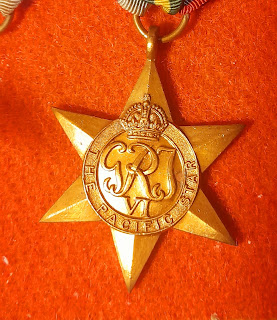Social History In 50 Objects Number 3. - The Pacific Star
Granda Haggerty was in the Royal Navy during the war and was awarded the Pacific Star but he never wore any of his medals or ever wore a poppy either.
This is because Granda was still fighting the Japanese in the Pacific right up until VJ day and by the time he got home, he couldn't get his old job back or find any other work or receive any financial help from the Earl Haig fund. For Wee Dinny, post-war Scotland wasn't 'a land fit for heroes'.
However, my Granda came back from the Pacific Campaign with a deep respect and admiration for Australians, and he actually wanted to move to Australia but my Gran didn't want to move way.
The other thing my Granda brought home from the war was a dislike of what he called "Teuchters' and 'Wee Frees' from the Isles and this antipathy towards Highlanders continued into his working life at the docks, in the shipyards and working on the boats too, where he faced regular anti-Irish racism and anti-Catholic bigotry at the hands of the 'Teuchters' and 'Wee Frees'.
My Granda's father came from County Mayo, he had been in the Leinster Regiment in WW1 and it was hoped that following both WW1 and then again after WW2, the old prejudices would be forgotten. Yet, despite Irish Catholics loyal service in both wars, the hostility continued.
Similarly, on St Patrick's Day 2024, our most preeminent local history expert Shaun Kavanagh, gave another excellent talk at the Beacon Arts Centre on relations between Irish Gaels and Highland Gaels in Greenock during the 19th century.
Fine academics like Shaun have undertaken serious scholarly research on this topic but Shaun also tells an exciting and fascinating tale of eviction, displacement, immigration, riots, pogroms, nativism, gang violence, fierce workplace competition for employment, local politics, protectionism, clanishness, mistrust, religious bigotry and the same old bitter sectarianism which persisted into the 20th century, experienced by men like my grandfather.
For me, this lack of shared common good and a pursuit of mutual self-interest between fellow displaced Gaels in Greenock, is a great travesty.
For example, my own parish of St Ninian's in Gourock was established by poor tenant farmers evicted from Gweedore in Donegal.
From here in Gourock, parishioners formed a branch of the Irish Land League called the Thomas Sexton branch, they used to meet in the Gamble Halls in Gourock and they continued to support the Land League back in Ireland. Especially, Fr McFadden the famous 'Fighting Priest of Gweedore'.
Around about the same time a Highland Crofter and land reform radical called John Morrison Davidson stood in Greenock as a candidate for the Scottish Land League Party.
The brilliant folk song made famous by Hamish Henderson 'John Maclean's March', makes a hopeful reference to this vision of solidarity between Presbyterian Highland Gaels (Maclean was of Gaelic Highland stock) and Irish Catholic Gaels - 'Hallo Pat Malone, I knew ye’d be here, son. The red and green, my lads, we’ll wear side by side'
Today my Granda's Pacific Star sits proudly on my mantlepiece as reminder of my family history - both Irish Catholic and Free Church Presbyterian and the common good which was eventually to be found in our Labour and Trade Union Movement.
So don't let them divide us today - Unionist or Nationalist, Republican or Loyalist, Scottish or English, Highland or Lowland, Liberal or Conservative, Town or Country, Student or Pensioner, Religous or Secular, Catholic or Protestant, Gay or Straight, Black or White, Muslim or Hindu, Immigrant or Indegenous, Trans or Terf.
Our interests still lie in standing together as a class for ourselves against those who would seek to exploit us...Solidarity yesterday, today and forever!



